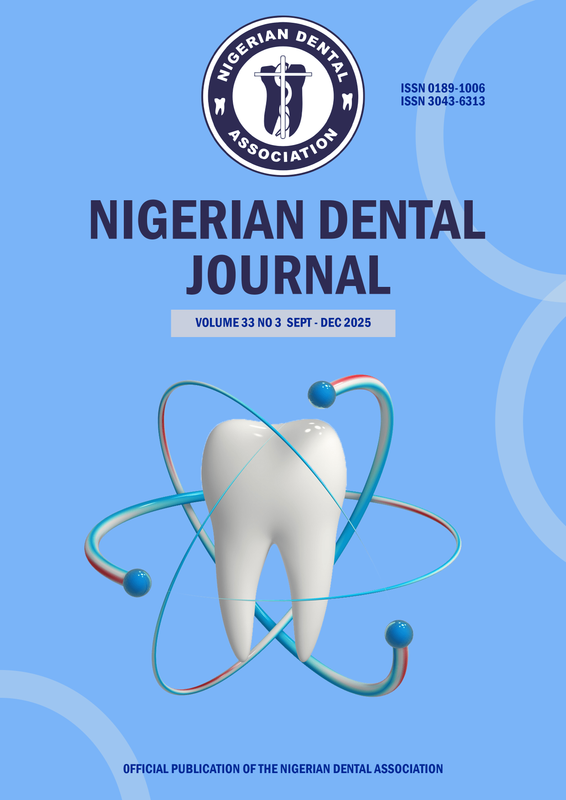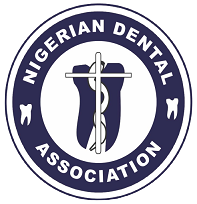MANAGEMENT OF UNERUPTED ANTERIOR TEETH: AN AUDIT OF TREATMENT OUTCOMES
Management of impacted anterior teeth
DOI:
https://doi.org/10.61172/ndj.v31i1.169Keywords:
central incisors, canines, impaction, management, outcomesAbstract
Introduction: Anterior teeth are valuable for aesthetics, speech and mastication . Their absence, impaction and/or delayed eruption create significant distress often leading to early presentation to the dental office. This study presents an audit of the management of impacted anterior teeth that presented at a tertiary level dental clinic. The periodontal outcomes of the aligned teeth were also reported.
Methods: This is an observational study spanning a nine-year period. Demographic data, clinical presentation as well as post alignment dental and periodontal status of the impacted teeth were assessed. Data was analysed using the Statistical Package for Social Sciences (SPSS) version 26. Fisher’s exact test and paired samples T-test were used for categorical and continuous variables respectively. Significance was set at P < 0.05.
Results: Twenty-eight (1.76%) cases presenting with failed eruption of thirty-two anterior teeth were found during the period under review. Eight patients were treated by extraction, orthodontic treatment and space closure or prosthetic replacement with a mean treatment time of 2.83 ± 2.66 years. Thirteen patients completed treatment by orthodontic alignment with mean alignment time of 1.4 ± 1.5 years and treatment time of 3.6 ± 2.5 years. There was significant difference in the post-operative root length of aligned teeth compared to their normal antimeres (p < 0.005).
Conclusion: Patients with impacted anterior teeth presented later than was beneficial for spontaneous alignment of their teeth. The average 1.5mm loss of root length observed was not detrimental to the anatomical retention or function of the aligned teeth. There is need for more enlightenment with regards to early presentation for dental problems to avoid expensive and time-consuming treatments.
Downloads
References
Huber KL, Suri L, Taneja P. Eruption Disturbances of the Maxillary Incisors: A Literature Review. J Clin Pediatr Dent, 2008. 32(3): p. 221-230.
Tanki JZ, Naqash TA, Gupta A, Singh R, Jamwal A. Impacted maxillary incisors : Causes, Diagnosis and Management. J Dent Med Sci, 2013. 5(2): p. 41-45.
Bartolo A, Camilleri A, Camilleri S. Unerupted incisors—characteristic features and associated anomalies. Eur J Orthod, 2010. 32: p. 297-301.
Potnis A, Panchasara C, Shetty A, Nayak UK. Unveiling the impacted incisor. Indian J Multidiscip Dent, 2015. 5(1): p. 27-30. https://doi.org/10.4103/2229-6360.163652
Singh H, Kapoor P, Sharma P, Dudeja P, Maurya R, Thakkar S. Interdisciplinary management of an impacted dilacerated maxillary central incisor. Dental Press J Orthod., 2018. 23(3): p. 37-46.
Almandaey AAQ. Surgical exposure , bonding and orthodontic traction of impacted maxillary anterior teeth : a retrospective study., in Dentistry. 2007, University of Hong Kong.: Pokfulam, Hong Kong. http://dx.doi.org/10.5353/th_b3976613
Manne R, Gandikota C, Juvvadi SR, Rama HRM, Anche S. Impacted canines: Etiology, diagnosis, and orthodontic management. J Pharm Bioallied Sci, 2012. 4: p. s234-238. https://doi.org/10.4103/0975-7406.100216
Ghosh A, Dhar S, Kar S. Orthodontic management of unfavorably impacted maxillary central incisor (sickle incisor). APOS Trends in Orthodontics, 2014. 4: p. 133-138.
Haralur SB, Shahrani S, Al-Alqahtani F, Nusair Y, Alshammari O, Alshenqety O. Incidence of impacted maxillary canine teeth in Saudi Arabian subpopulation at central Saudi Arabian region. Ann Trop Med Public Health, 2017. 10(3): p. 558–562.
Mengal N, Kahooja KK, Ahmed M. Surgical Uncovering and Orthodontic Positioning of Unerupted Maxillary Right Canine and Left Central Incisor. Journal of the College of Physicians and Surgeons Pakistan, 2018. 28: p. s133-134.
Pavoni C, Mucedero M, Laganà G, Paoloni V, Cozza P. Impacted maxillary incisors: diagnosis and predictive measurements. Annali di Stomatologia, 2012. III(3/4): p. 100-105.
Khera AK, Rohilla A, Tandon P, Singh GP. Orthodontic management of impacted central incisor : A clinical challenge. J Ind Orthod Soc, 2017. 51: p. 46-50. https://doi.org/10.4103/0301-5742.199249
Kafle D, Shrestha S, Acharya N, Agarwal A. Prevalence of Maxillary Central Incisor Impaction and Supernumerary Teeth among Nepalese Orthodontic Patients. Orthod J Nepal, 2015. 5(2): p. 14-16.
Sanu OO, Temisanren OT. A review of 39 cases of unerupted maxillary incisors. Nig J Clin Practice, 2002. 6(1): p. 60-64.
Thosar NR, Vibhute P. Surgical and orthodontic treatment of an impacted permanent central incisor : A case report. J Indian Soc Pedod Prev Dent, 2006. 24: p. 100–103.
Sharmila R. Incidence of Impacted Canine Using Orthopantomogram. J Pharm Sci & Res, 2016. 8(8): p. 912-922.
Al-Ayed FA, Al-Wehiby SM, Ettesh A. The prevalence of impacted permanaet canines in Saudi subpopulation: an original research. . J Am Sci, 2019. 15()(1): p. 29–33. https://doi.org/10.7537/marsjas150119.05.
Avinash K, Aieshya F. Impacted maxillary central incisor and over-retained deciduous central incisor: Combined surgical and orthodontic treatment - A case report. J. Int Oral Health, 2011. 3(3): p. 25-30.
Subbiah Kannan PK, Palanisamy SK, Kumar TS. A case of impacted maxillary central incisor and its management. J Pharm Bioallied Sci., 2012. 4: p. s174-176.
Kumar R, Thomas AM. Orthodontic Alignment of an Impacted Maxillary Incisor : A Case Report. Int J Sci Study, 2015. 2(10): p. 136-138. https://doi.org/10.17354/ijss/2015/33
Fujita Y, Takahashil T, Maki K. Orthodontic treatment for an unerupted and severely rotated maxillary central incisor. A case report. Eer J. Paed Dent, 2008: p. 43-47.
Vermette ME, Kokich VG, Kennedy DB. Uncovering labially impacted teeth: apically positioned flap and closed eruption techniques. The Angle Orthodontist, 1995. 65(1): p. 23-34.
Kalaskar RR, Kalaskar AR. Multidisciplinary management of impacted central incisors due to supernumerary teeth and an associated dentigerous cyst. Contemp Clin Dent, 2011. 2(1): p. 53–58. https://doi.org/10.4103/0976
Tan C, Ekambaram M, Yiu CKY. Prevalence, characteristic features, and complications associated with the occurrence of unerupted permanent incisors. PLOS ONE, 2018. 13(6): p. e0199501.
Seehra J, Yaqoob O, Patel S, O’Neill J, Bryant C, Noar J, et al. National clinical guidelines for the management of unerupted maxillary incisors in children. British Dent. J, 2018. 224(10): p. 779-785.
Caminiti MF, Sandor GK, Giambattistini C, Tompson B. Outcomes of the surgical exposure, bonding and eruption of 82 impacted maxillary canines. J Can Dent Assoc, 1998. 64(8): p. 572-4, 576-9. https://www.ncbi.nlm.nih.gov/pubmed/9785687
Temisanren OT, Ifesanya JU, Olatunji AB. Compliance to review attendace among orthodontic patients attending a tertiary level health care centre. Nig Dent J, 2015. 23(1): p. 130-134.
Nelson, S.J., The permanent Canines, in Wheeler's Dental Anatomy, Physiology and Occlusion. 2015, Elsevier Saunders: St. Louis, Missouri. p. 123-129.
Downloads
Published
Issue
Section
License
Copyright (c) 2023 Joy U Ifesanya, Orighoye T Temisanren, Timothy O Aladelusi, Adeola A Olusanya

This work is licensed under a Creative Commons Attribution 4.0 International License.
Open Access Statement
- We became fully Open Access since January 2023.
- Our new and archived materials are available free of charge on open basis and under a Creative Commons license as stated below.
Copyright statement
Copyright © 1999 The authors. This work, Nigerian Dental Journal by Nigerian Dental Association is licensed under Creative Commons Attribution 4.0 International License.


